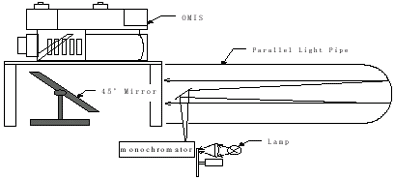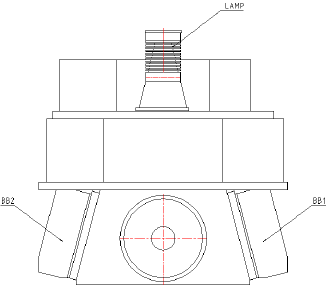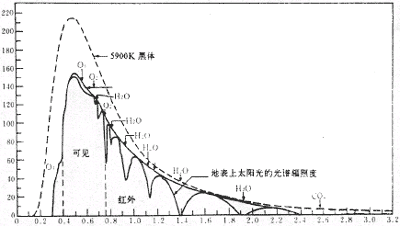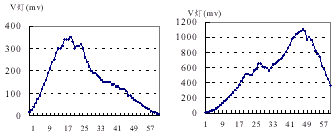| GISdevelopment.net ---> AARS ---> ACRS 1999 ---> Poster Session 2 |
Research on Calibration
Technology of Airborne Imaging Spectrometer
Shen Mingming, Fang
Kangmei, Zhao shuhua, He Weixin
( Shanghai Institute of Technical Physics, Chinese Academy of Sciences , Shanghai 200083, China )
( Shanghai Institute of Technical Physics, Chinese Academy of Sciences , Shanghai 200083, China )
Summary
The basis for putting airborne imaging spectrometer technology into practical application is to quantize the data of the imaging spectrometer and establish the quantified relationship between digital output and spectral radiance. High accurate calibrated system on the ground and on-board calibrator are the necessary conditions for conducting the research on quantization of imaging spectrometer data. This paper mainly introduces the calibration system for an OMIS.Operative Modular Imaging Spectrometer.developed by Shanghai Institute of Technical Physics, Chinese Academy of Sciences
1. Introduction
Today when remote sensing technique has been developing towards practical application , interpretation of remote sensing images just from relatively strong or weak intensity of targets radiation cannot meet the need of practical application.. The requirement for quantization of data is becoming more and more important. The successful development of imaging spectrometer enables simultaneous imaging of the same ground objects at hundred of continuous spectral bands. The spectral resolution of OMIS is of NM level. Since the remote sensing data contains both images and spectra of a target it is possible to obtain, from remote sensing,, spectral characteristics of the target which are similar to those in a lab. The relative radiation information obtained from the remote sensing imaging data itself basically meets the need for remote sensing target extraction and classification. Quantified parameters of the instrument must be provided for further target recognition and image interpretation.
The response of an OMIS can be divided into spectral response and radiation response. The influence of the environment. temperature.impact and the variation in optics, mechanics of the instrument itself and in the performances of detectors will make the system response vary . The major reason for further progress of OMIS is that it is hard to effectively compare the information acquired at different time by the same instrument or the information of the same target acquired by different instruments. In order to establish quantified relationship between the digital output of the OMIS and the radiance of a target it is important to conduct absolute calibration on the spectral radiance of the spectrometer. Normally accurate calibration of the instrument is carried out in a laboratory, at the same time the variation in the system response is monitored. Therefore, setting up a ground calibration system and on-board calibrator for visible and short-wave IR bands are one of the important contents in the development of new generation of OMIS.
2. Requirement for Calibration of OMIS
The detecting spectral range of OMIS (Operative Modular Imaging Spectrometer) is from 0.46mm to 12.5mm with 128 bands consisting of five Spectrometers .For application purpose requirements for calibration accuracy for various bands of the OMIS are given in table 1:
Table1. Calibration Requirements of
the OMIS
3. Laboratory Calibration System of OMIS
3.1 Spectral calibration
The role of laboratory calibration is to determine the central wavelength and the bandwidth of various channels of OMIS.
An ideal calibration light source should fully fill the field of view and aperture, be monochromatic and uniformly distributed. However, the aperture of the imaging spectrometer is large and its spectral resolution is high, it is to realize an ideal calibration light source. Therefore, the spectral calibration process under nonideal light was studied. Usually calibration light source consists of a monochromator and a collimator for spectral calibration in lab. In order to obtain good monochrome the slit of the monochromator must be small, e.g. if the highest spectral resolution of the imaging spectrometer is 10nm,the resolution of the monochromator is at least 1nm or so. The slit of the monochromator must be so small that it will not fully fill the field of view. At that time the image of the slit on the detector can be rotated by 90. Since the slit usually has enough height and if the height of the slit is changed into width, the requirement of filling the fieldofview of disperse direction is met with.
When the monochromator scans at certain scanning step length, corresponding spectral response curves can be obtained for various channels of the imaging spectrometer, which can determene the central wavelengths of various bands and equivalent spectral nand width. Figs 3.1 and 3.2 show the structure of the calibration system and the light path.

Fig 3.1 Structure of the Calibration System

Fig 3.2 Light path of the Calibration System
3.2 Radiometric calibration
Radiation calibration is to determine the corresponding relationship between the response value of each channel of the imaging spectrometer and incident radiation. The key point for a radiation calibration system is to establish a set of standard radiation sources with high accuracy and high stability. High and low temperature blackbodies covering the entire field of view were adopted for the calibration in thermal infrared band. For the band of 0.45 µm to 2.5mm a large aperture integrating sphere radiation source with good area uniformity. The integrating sphere has a diameter of 900mm with a hole of 240mm; inside the sphere there are eight quartz halogen tungsten lamps of 250 W with a peak radiance of 2.46E-5w/cm2 Sr nm ( 960-970nm). The interior of the integrating sphere is coated with BaSO4 and F4mixed diffuse reflection materials. The output radiance of the integrating sphere gives 8level absolution spectral radiation via accurate radiation standard transfer.
The establishment of radiometric calibration system is the transfer process of radiometric standards. It involves the recurrence of standards, contrast measurement, reference medium etc. High precision of the calibration system can not be guaranteed unless the error source is controlled. Calibration of the imaging spectrometer by the radiometric calibration system can determine the radiation sensitivity of various bands of the instrument, linearity of response, dark current. the influence of stray radiation etc.
4. Onboard calibration
An on-board calibrator is used to calibrate the imaging spectrometer during flight. Its role is to provide radiation reference data for checking the relative stability of spectral and radiometric response of each channel of the instrument during operation. The OMIS system is equipped with a calibration lamp for visible and short wave infrared channels and two radiometric calibration blackbodies for middle infrared and thermal infrared . Three calibrators are distributed uniformly on both sides of the zenith and scanning window of the imaging spectrometer (Fig. 4.1 ). In every scanning the instrument observes and records earth object and each calibrator once. The difference between the current level of the blackbody and the signal of the calibration lamp can be used as relative radiation reference for visible and far IR and short wave IR.

Figure 4.1 Layout of the Onboard Calibration System
4.1 Blackbody
A carefully made blackbody can be used as firstlevel calibration source of thermal radiance. A temperature control unit adjusts the temperature of blackbodies BB1 and BB2 to make it stable at its set temperature. The blackbody temperature controlled by the first level thermal-electric unit that spans from –15to 50can meet the need. of operation. The precision of the blackbody temperature is controlled at about ±0.2and display indicates ±0.1. Ideal requirement for the blackbody as radiation standard surface is that the spectral emissivity of the blackbody is 1.0, but it is rather difficult to make such a perfect blackbody. A simple way is to paint a layer of black painting which has a high spectral emissivity of 0.94. With this emissivity the reflectivity will be 0.06 which indicates that during calibration, the blackbody also contains 6% reflective energy of environment radiation beside its own radiation. So in quantitative analysis of remote sensing data, we must consider the influence of environment introduced by the 6% reflective energy. The spectral emissivity variance of 0.1 is equal to the blackbody temperature variance of 0.6K.
4.2 Calibration Light
The calibration source for the bands below 2.5mm.from visible to short wave infrared.is a new research topic. Several experiment schemes were designed, such as, putting a diffuse lamp box on one side of scan mirror as calibration source brought into stray light which would influence the imaging system and change with different rotation positions of the scanning mirror. Experiments proved that adopting a collimating lens and mounting it on the top of the scanning mirror is practical. Since at this spectral range, the incident radiation mainly comes from the reflective energy of the sun radiation by ground objects. Fig 4.2 shows the radiation curve of the sun outside atmosphere layer and above the sea level. So the spectral distribution of the onboard calibration lamp source should match the sun spectra as much as possible.

Fig4.2 Radiation curve of the sun

Fig4.3 Spectrum distributing of the halogen tungsten lamp
If a halogen tungsten lamp is used as calibration source, its radiance peak is around 1 µm as shown in Fig. 4.3. In order to make the spectra distribution of both the same and take the sun spectra as standard, ideal approach is to make the radiation of the lamp source pass through a series of specially made filters to balance the relative radiation intensity of short wave IR and visible light. For efficient and practical purpose, we put a special filter in front of the halogen tungsten lamp and achieved good correction result. Fig 4.4 shows the curve of response of various bands of OMIS to the calibration lamp. From Fig 4.4a without a filter , we see that the response peak is at the 47 th band (970nm.and Fig. 4.4b with a filter the response peak moved to the 21th band.710nm..
Fig 4.4 the response curve in OMIS to the calibration lamp
5. Conclusion
Quantified research on remote sensing imaging data is a key step for imaging spectrometer to be put into application, which has received much attention in the remote sensing circle. It is, however, a very difficult task to conduct absolute radiometric calibration with high accuracy in the bands from VIS to NIR region. In order to get the quantified remote sensing data, laboratory calibration must include standard data processing and analysing system apart from setting up a high precision radiometric calibration system. The realization of this goal needs further study and experiments.
References
The basis for putting airborne imaging spectrometer technology into practical application is to quantize the data of the imaging spectrometer and establish the quantified relationship between digital output and spectral radiance. High accurate calibrated system on the ground and on-board calibrator are the necessary conditions for conducting the research on quantization of imaging spectrometer data. This paper mainly introduces the calibration system for an OMIS.Operative Modular Imaging Spectrometer.developed by Shanghai Institute of Technical Physics, Chinese Academy of Sciences
1. Introduction
Today when remote sensing technique has been developing towards practical application , interpretation of remote sensing images just from relatively strong or weak intensity of targets radiation cannot meet the need of practical application.. The requirement for quantization of data is becoming more and more important. The successful development of imaging spectrometer enables simultaneous imaging of the same ground objects at hundred of continuous spectral bands. The spectral resolution of OMIS is of NM level. Since the remote sensing data contains both images and spectra of a target it is possible to obtain, from remote sensing,, spectral characteristics of the target which are similar to those in a lab. The relative radiation information obtained from the remote sensing imaging data itself basically meets the need for remote sensing target extraction and classification. Quantified parameters of the instrument must be provided for further target recognition and image interpretation.
The response of an OMIS can be divided into spectral response and radiation response. The influence of the environment. temperature.impact and the variation in optics, mechanics of the instrument itself and in the performances of detectors will make the system response vary . The major reason for further progress of OMIS is that it is hard to effectively compare the information acquired at different time by the same instrument or the information of the same target acquired by different instruments. In order to establish quantified relationship between the digital output of the OMIS and the radiance of a target it is important to conduct absolute calibration on the spectral radiance of the spectrometer. Normally accurate calibration of the instrument is carried out in a laboratory, at the same time the variation in the system response is monitored. Therefore, setting up a ground calibration system and on-board calibrator for visible and short-wave IR bands are one of the important contents in the development of new generation of OMIS.
2. Requirement for Calibration of OMIS
The detecting spectral range of OMIS (Operative Modular Imaging Spectrometer) is from 0.46mm to 12.5mm with 128 bands consisting of five Spectrometers .For application purpose requirements for calibration accuracy for various bands of the OMIS are given in table 1:
| Spectrometer | Spectral region(mm) | Channels | Spectral interval (nm) | Spectral calibration accuracy(nm) | radiometric calibration sensitivity | radiometric calibration SNR |
| 1 | 0.46 ~ 1.1 | 64 | 10 | ±2 | 0.02mw/cm2Srmm | 300 |
| 2 | 1.06 ~ 1.7 | 16 | 40 | ±5 | 0.01 mw/cm2Srmm | 80 |
| 3 | 2.0 ~ 2.5 | 32 | 15 | ±2 | 0.01mw/cm2Srmm | 80 |
| 4 | 3.0 ~ 5.0 | 8 | 250 | ±50 | 0.1k | 80 |
| 5 | 8.0 ~ 12.5 | 8 | 500 | ±50 | 0.1k | 80 |
3. Laboratory Calibration System of OMIS
3.1 Spectral calibration
The role of laboratory calibration is to determine the central wavelength and the bandwidth of various channels of OMIS.
An ideal calibration light source should fully fill the field of view and aperture, be monochromatic and uniformly distributed. However, the aperture of the imaging spectrometer is large and its spectral resolution is high, it is to realize an ideal calibration light source. Therefore, the spectral calibration process under nonideal light was studied. Usually calibration light source consists of a monochromator and a collimator for spectral calibration in lab. In order to obtain good monochrome the slit of the monochromator must be small, e.g. if the highest spectral resolution of the imaging spectrometer is 10nm,the resolution of the monochromator is at least 1nm or so. The slit of the monochromator must be so small that it will not fully fill the field of view. At that time the image of the slit on the detector can be rotated by 90. Since the slit usually has enough height and if the height of the slit is changed into width, the requirement of filling the fieldofview of disperse direction is met with.
When the monochromator scans at certain scanning step length, corresponding spectral response curves can be obtained for various channels of the imaging spectrometer, which can determene the central wavelengths of various bands and equivalent spectral nand width. Figs 3.1 and 3.2 show the structure of the calibration system and the light path.

Fig 3.1 Structure of the Calibration System

Fig 3.2 Light path of the Calibration System
3.2 Radiometric calibration
Radiation calibration is to determine the corresponding relationship between the response value of each channel of the imaging spectrometer and incident radiation. The key point for a radiation calibration system is to establish a set of standard radiation sources with high accuracy and high stability. High and low temperature blackbodies covering the entire field of view were adopted for the calibration in thermal infrared band. For the band of 0.45 µm to 2.5mm a large aperture integrating sphere radiation source with good area uniformity. The integrating sphere has a diameter of 900mm with a hole of 240mm; inside the sphere there are eight quartz halogen tungsten lamps of 250 W with a peak radiance of 2.46E-5w/cm2 Sr nm ( 960-970nm). The interior of the integrating sphere is coated with BaSO4 and F4mixed diffuse reflection materials. The output radiance of the integrating sphere gives 8level absolution spectral radiation via accurate radiation standard transfer.
The establishment of radiometric calibration system is the transfer process of radiometric standards. It involves the recurrence of standards, contrast measurement, reference medium etc. High precision of the calibration system can not be guaranteed unless the error source is controlled. Calibration of the imaging spectrometer by the radiometric calibration system can determine the radiation sensitivity of various bands of the instrument, linearity of response, dark current. the influence of stray radiation etc.
4. Onboard calibration
An on-board calibrator is used to calibrate the imaging spectrometer during flight. Its role is to provide radiation reference data for checking the relative stability of spectral and radiometric response of each channel of the instrument during operation. The OMIS system is equipped with a calibration lamp for visible and short wave infrared channels and two radiometric calibration blackbodies for middle infrared and thermal infrared . Three calibrators are distributed uniformly on both sides of the zenith and scanning window of the imaging spectrometer (Fig. 4.1 ). In every scanning the instrument observes and records earth object and each calibrator once. The difference between the current level of the blackbody and the signal of the calibration lamp can be used as relative radiation reference for visible and far IR and short wave IR.

Figure 4.1 Layout of the Onboard Calibration System
4.1 Blackbody
A carefully made blackbody can be used as firstlevel calibration source of thermal radiance. A temperature control unit adjusts the temperature of blackbodies BB1 and BB2 to make it stable at its set temperature. The blackbody temperature controlled by the first level thermal-electric unit that spans from –15to 50can meet the need. of operation. The precision of the blackbody temperature is controlled at about ±0.2and display indicates ±0.1. Ideal requirement for the blackbody as radiation standard surface is that the spectral emissivity of the blackbody is 1.0, but it is rather difficult to make such a perfect blackbody. A simple way is to paint a layer of black painting which has a high spectral emissivity of 0.94. With this emissivity the reflectivity will be 0.06 which indicates that during calibration, the blackbody also contains 6% reflective energy of environment radiation beside its own radiation. So in quantitative analysis of remote sensing data, we must consider the influence of environment introduced by the 6% reflective energy. The spectral emissivity variance of 0.1 is equal to the blackbody temperature variance of 0.6K.
4.2 Calibration Light
The calibration source for the bands below 2.5mm.from visible to short wave infrared.is a new research topic. Several experiment schemes were designed, such as, putting a diffuse lamp box on one side of scan mirror as calibration source brought into stray light which would influence the imaging system and change with different rotation positions of the scanning mirror. Experiments proved that adopting a collimating lens and mounting it on the top of the scanning mirror is practical. Since at this spectral range, the incident radiation mainly comes from the reflective energy of the sun radiation by ground objects. Fig 4.2 shows the radiation curve of the sun outside atmosphere layer and above the sea level. So the spectral distribution of the onboard calibration lamp source should match the sun spectra as much as possible.

Fig4.2 Radiation curve of the sun

Fig4.3 Spectrum distributing of the halogen tungsten lamp
If a halogen tungsten lamp is used as calibration source, its radiance peak is around 1 µm as shown in Fig. 4.3. In order to make the spectra distribution of both the same and take the sun spectra as standard, ideal approach is to make the radiation of the lamp source pass through a series of specially made filters to balance the relative radiation intensity of short wave IR and visible light. For efficient and practical purpose, we put a special filter in front of the halogen tungsten lamp and achieved good correction result. Fig 4.4 shows the curve of response of various bands of OMIS to the calibration lamp. From Fig 4.4a without a filter , we see that the response peak is at the 47 th band (970nm.and Fig. 4.4b with a filter the response peak moved to the 21th band.710nm..
 | |
| a. Lamp with a filter | b. Lamp without a filter |
Fig 4.4 the response curve in OMIS to the calibration lamp
5. Conclusion
Quantified research on remote sensing imaging data is a key step for imaging spectrometer to be put into application, which has received much attention in the remote sensing circle. It is, however, a very difficult task to conduct absolute radiometric calibration with high accuracy in the bands from VIS to NIR region. In order to get the quantified remote sensing data, laboratory calibration must include standard data processing and analysing system apart from setting up a high precision radiometric calibration system. The realization of this goal needs further study and experiments.
References
- D. Oertel. On-ground Calibration Facility for VIS-TIR Wide-angle Videospectrometric Airborne Sensors
- DLR-Institute of Optoelectronics 82230 Wessling / Germany August, 1993.
- Gregg Vane et al.,
- Remote Sensing Environ. 1993,44:127-143
- Shen Mingming, Proceedings of the Third Internationnal
- Airborne Remote Sensing Conference, II-255-262
- July 1997. Copenhagen, Denmark
- He Weixin, Master’s Dissertation of SITP,
- P2-8, 1998.